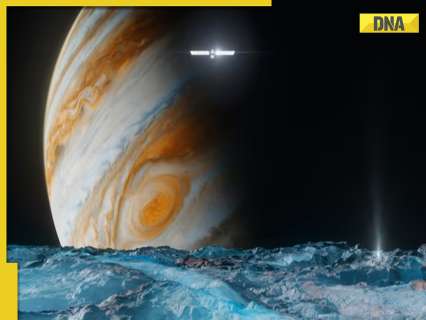
previous data from studies indicate that underneath the frozen crust of Jupiter’s moon there lies a huge salt-water ocean, which could possibly support life forms.
A spacecraft is set to launch on Monday from the Kennedy Space Center towards Jupiter with the mission to hunt for signs of alien life on Europa one of the moons orbiting the distant planet.
Previous data from studies indicate that underneath the frozen crust of Jupiter’s moon there lies a huge salt-water ocean, which could possibly support life forms. “We’re going on a 1.8-billion-mile journey to an ocean world – Jupiter moon, Europa!” the US space agency NASA said this morning on X ahead of the anticipated blast off.
NASA’s flagship spacecraft ‘Europa Clipper’ mission, the largest spacecraft the US space agency developed for a planetary mission, was supposed to have launched earlier but got delayed due to Hurricane Milton, which swept through Florida on October 9-10. Both the Clipper and the SpaceX Falcon Heavy rocket were secured inside a SpaceX hanger near their launch pad at NASA’s Kennedy Space Center, agency officials said on X.
The probe is billed to be around USD 5.2 million. After the launch, the spacecraft plans to fly by Mars in February 2025, and then back by Earth in December 2026, using the gravity of each planet to increase its momentum. With the help of these “gravity assists,” Europa Clipper will achieve the velocity needed to reach Jupiter in April 2030.
Earlier on April 14, 2023, the European Space Agency had launched the Jupiter Icy Moons Explorer (Juice) mission from Europe’s Spaceport in French Guiana to study Jupiter and its three large ocean-bearing moons – Ganymede, Callisto and Europa. Juice, however, is expected to arrive at Jupiter only by July 2031.The Europa Clipper spacecraft will have travelled 1.8 billion miles (2.9 billion kilometre) to reach Jupiter in April 2030.
It will orbit Jupiter, and conduct 49 close flybys of Europa. During these flybys, the spacecraft’s nine science instruments will collect data on the moon’s atmosphere, its ice crust, and the ocean underneath. The nearly 10-feet-wide (3-meter) dish-shaped antenna and several smaller antennas will transmit the data to Earth, a trip that will take about 45 minutes when the spacecraft is in orbit around Jupiter, NASA said.
The antenna will operate on NASA’s deep space X-band radio frequencies through the agency’s Deep Space Network, a global array of large radio antennas that communicate with dozens of spacecraft throughout the solar system.
“Although Europa Clipper is not a life-detection mission, understanding Europa’s habitability will help us better understand how life developed on Earth and whether we’re likely to find conditions that might support life beyond our planet,” the NASA stated.
Europa Clipper instruments include cameras, spectrometers, a magnetometer, and an ice-penetrating radar. These instruments will study Europa’s icy shell, the ocean beneath, and the composition of the gases in the moon’s atmosphere and surface geology, and provide insights into the moon’s potential habitability.
The spacecraft will also carry a thermal instrument to pinpoint locations of warmer ice and any possible eruptions of water vapour. Strong evidence shows the ocean beneath Europa’s crust is twice the volume of all the Earth’s oceans combined, the US space agency detailed.
Scientists from NASA, the Jet Propulsion Lab and the Johns Hopkins Applied Physics Lab are involved in NASA’s Europa Clipper mission. In 1610, Galileo Galilei made the first detailed observations of Jupiter with a homemade telescope. NASA’s first spacecraft to visit the outer planets, Pioneer 10 was designed as a 21-month mission to Jupiter, yet lasted more than 30 years.
After its Jupiter encounter in 1973, it continued beyond the solar system, sending its last signal to Earth in January 2003 from a distance of 7.6 billion miles. Pioneer 11, a sister spacecraft to Pioneer 10 flew even closer to Jupiter in 1974 en route to its destination, Saturn. After studying the ringed planet, Pioneer 11 exited the solar system, and like its sibling carries a plaque with a message for any intelligent beings that may encounter it.
As it flew by Jupiter in March 1979, Voyager 1 discovered a thin ring around the planet, two new moons, and active volcanoes on the volatile moon Io, before continuing on to Saturn and interstellar space. Voyager 2 began transmitting images of Jupiter April 24, 1979, for time-lapse movies of atmospheric circulation. Unlike Voyager 1, Voyager 2 made close passes to the Jovian moons on its way into the system, with scientists especially interested in more information from Europa and Io.
Later, the Galileo spacecraft orbited the gas giant for almost eight years, and dropped a probe into its atmosphere. It was the first spacecraft to enter Jupiter’s atmosphere. The Cassini spacecraft took detailed photos of Jupiter on its way to neighbuoring Saturn as did New Horizons on its journey to Pluto and the Kuiper Belt.
NASA spacecraft Juno has been studying Jupiter from orbit since July 2016. It’s probing beneath the planet’s dense clouds to answer questions about its origin and evolution, and is scheduled to continue investigating the solar system’s largest planet, its moons, faint rings, and surrounding environment through September 2025.
(This story has not been edited by DNA staff and is published from ANI)
